A customer intimacy strategy gives SMBs a powerful edge in crowded markets.
When you understand your audience, you can meet their needs faster and more accurately. You build trust and stronger, lasting relationships.
The result is stronger retention, higher customer lifetime value (CLV) and more referrals.
This guide shows you how to grow sales by getting closer to your customers. It includes real customer intimacy examples and practical tips to shape your strategy.
Key takeaways from customer intimacy
Customer intimacy is one of three key market leadership strategies in the Value Disciplines framework.
Trust, feedback and strong frontline support turn average customer relationships into more profitable ones.
Track customer intimacy success through metrics like retention rates, CLV, NPS scores and upsell revenue – readily available in your sales CRM and marketing tools.
Pipedrive helps you scale customer intimacy with personalization, smart data management, easy integrations and workflow automation. Start a free 14-day trial today and get closer to your audience.
What is customer intimacy?
Customer intimacy is a business strategy that builds close relationships with individual buyers to increase sales and retention.
It’s all about tailoring solutions to each customer’s needs to create exceptional value over time – a form of in-depth personalization.
The concept comes from Michael Treacy and Fred Wiersema’s Value Disciplines model.
Published in Harvard Business Review in 1993, this framework shows companies three ways to lead their markets:
Operational excellence. Deliver products at competitive prices with minimal hassle. Amazon leads e-commerce this way through low costs, efficiency and reliability.
Product leadership. Launch breakthrough products before competitors do. Apple uses this approach with frequent tech innovations that keep customers loyal.
Customer intimacy. Provide customized products and services for specific customer needs. Accenture uses this approach by tailoring its consulting through close client partnerships.
Companies can focus on one area for differentiation while maintaining basic performance in the other two.
That basic level is the “threshold value”, the minimum performance needed in secondary areas. Here’s how it works:
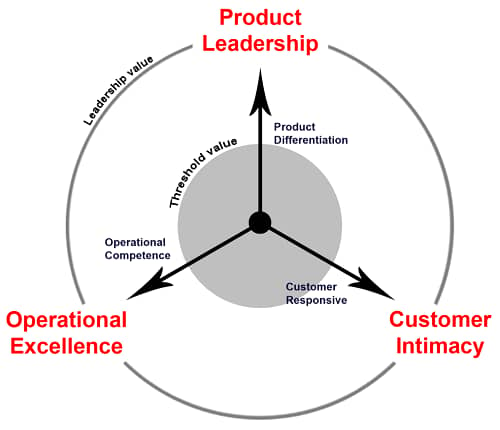
If you prioritize customer intimacy, you’ll still need efficient operations and reliable products to succeed. You just don’t have to excel in those secondary areas.
Customer intimacy puts buyers at the heart of business decisions. Like customer-centricity, this approach delivers better services and stronger relationships.
Why customer intimacy works so well for SMBs
Customer intimacy works best for small and medium-sized businesses.
Rather than extensive infrastructure or market research budgets, this approach focuses on relationships and quick responses.
A small retailer can’t match Amazon’s efficiency without massive logistics networks. Even large businesses struggle with this challenge.
However, it can stand out by remembering repeat customers, adjusting products to meet local demand and delivering hyper-personalized content.
Take a look at how pet brand Chewy did it:

Customer intimacy helped fuel Chewy’s early success. News of these personal touches spread quickly online, building brand awareness.
Intimacy is also more achievable for SMBs as they’re naturally closer to audiences.
With fewer customers, you can easily monitor what people value and how they buy. This allows you to adjust your pricing, sales and marketing strategies accordingly.
Building customer intimacy: a simple 5-part strategy
Forget the grand gestures for a minute. Customer intimacy happens through small, consistent actions across every touchpoint.
Here’s how to make customers feel understood and valued.
1. Personalize experiences with CRM and segmentation
Organize your customer data to understand individual preferences and behaviors better.
Use a customer relationship management (CRM) system like Pipedrive to track interactions and purchases. This software will help you keep track of personal details that can inform future engagements.
Here’s a simple workflow to start with:
Record personal details customers share with your team – like birthdays, interests, business milestones or family information
Segment your customer base by factors like purchase frequency, product preferences or business size
Build personalized email campaigns that reference past purchases or suggest relevant new products
Train team members to review customer profiles before calls or meetings
Imagine a sales rep opens Pipedrive’s contact detail view before checking in with a hot lead.
In the notes, they see the buyer loves to travel and mentions recent trips in most calls. It provides instant common ground and a way to stand out.
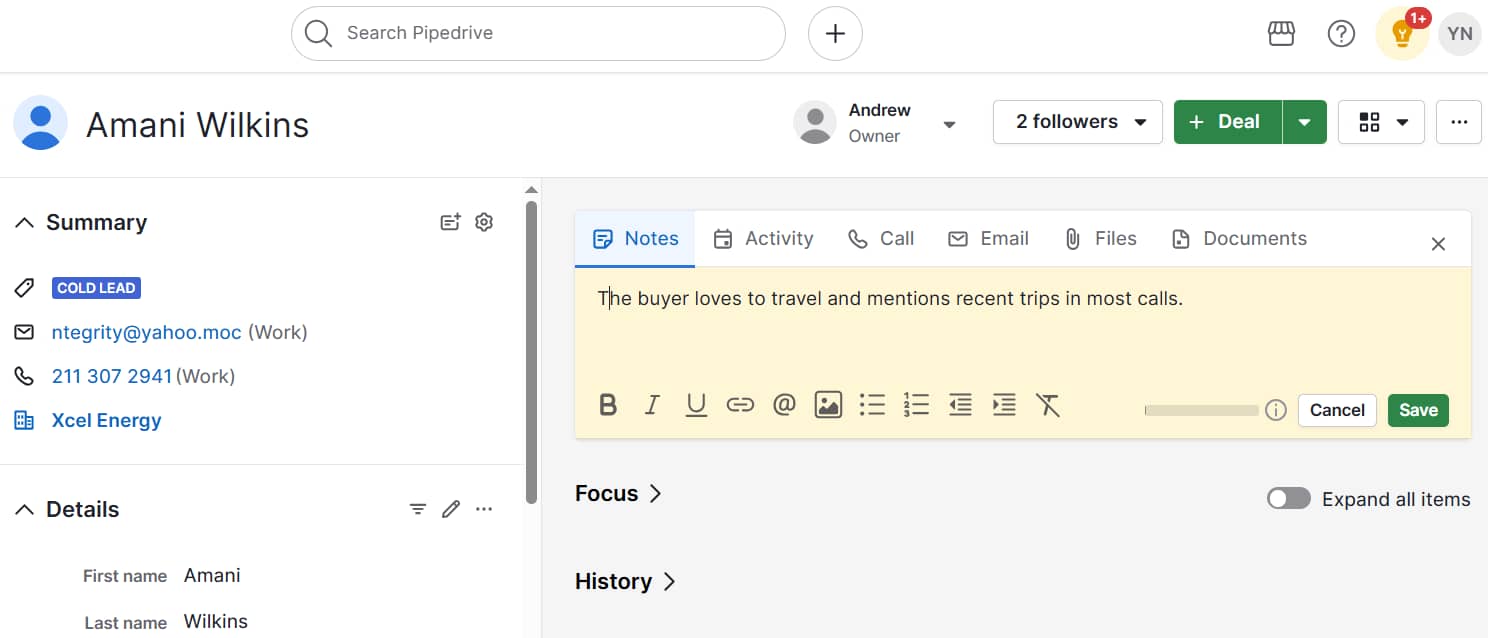
Instead of the usual “How’s business?”, the rep asks, “Been anywhere interesting this month?”.
That one small CRM-informed personalization instantly makes the conversation more intimate. It shows the rep’s attentiveness and tells the lead they’re more than just another customer.
It builds trust, forging a smoother path to honest business discussion.
Pipedrive in action: SaaS company Falcon uses Pipedrive’s custom fields to collect detailed customer data. Its sales and success teams use this information to personalize interactions. Marketing Operations Manager May Laursen said, “[Pipedrive] brings us closer to the customers, understanding their needs and mapping their relationship with us.”
2. Build trust through transparency and communication
Make honesty your default approach.
Use sales conversations, marketing content and every customer interaction to communicate key information clearly.
Customers should quickly find and understand:
Product capabilities
Pricing and add-on costs
Policies (e.g., usage, security measures)
Service levels (e.g., response times, support availability)
FreshBooks’ pricing page is a great example. It details each plan’s inclusions and add-on costs and “Information” buttons provide more details.
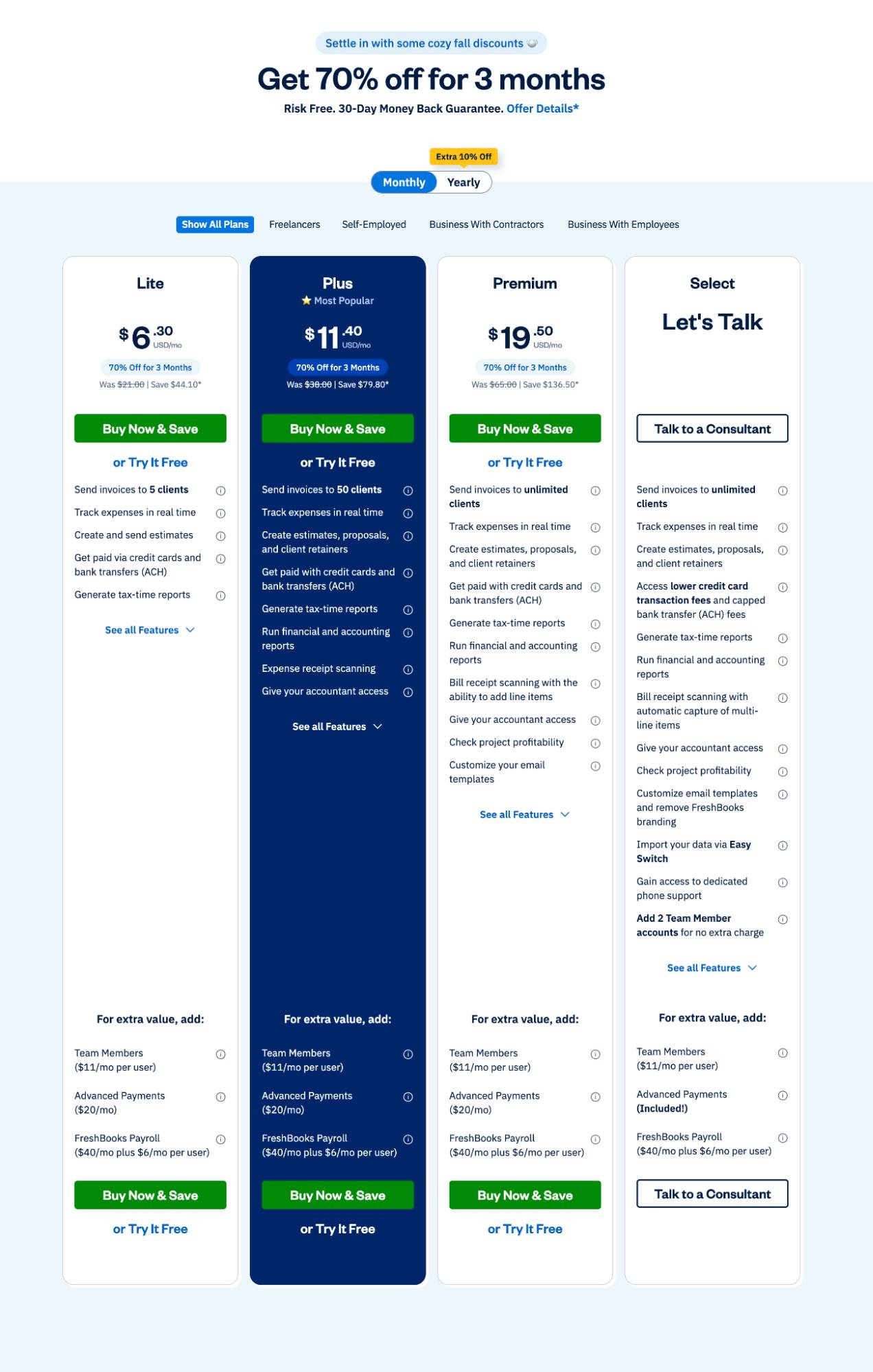
Letting people know what to expect builds trust, which translates to more sales and loyalty.
A 2025 Edelman survey shows trust influences buying decisions as much as cost and quality. 88% of respondents marked it either important or a dealbreaker.
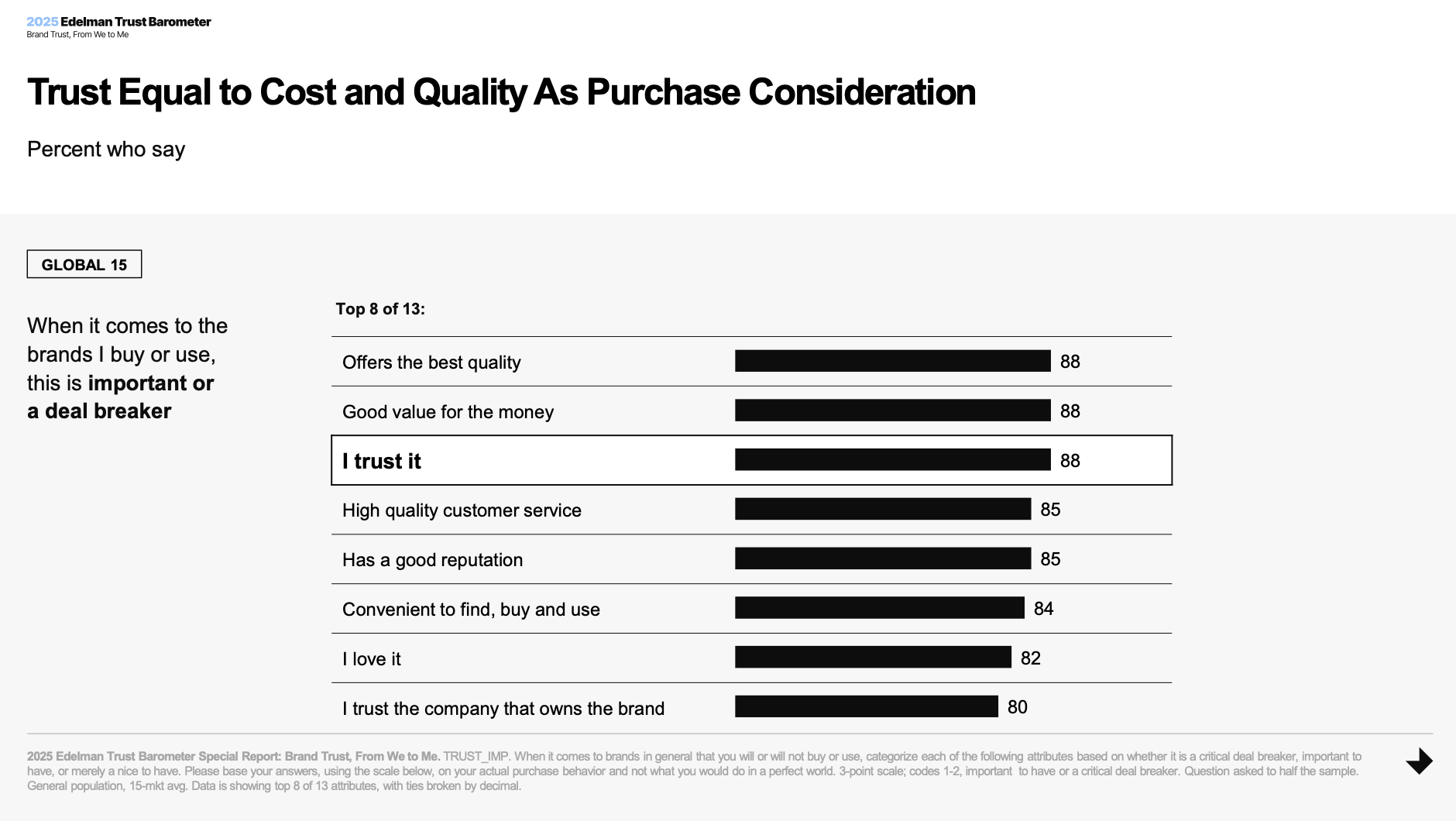
Qualtrics also found that “consistently delivering on promises” was one of the top 10 drivers of brand trust. The most successful companies do this to keep customers close.
When mistakes happen, own them.
Inform customers of delays before they raise an issue. Apologize for the downtime and say how you’ll fix it.
Research reveals that customers who complain want more than refunds. They want to feel heard, respected and taken seriously.
Prevent failure with your guide to handling tricky sales situations
3. Gather and act on customer feedback
Listen carefully to what customers say and show that their voices matter by acting on the input.
With so many ways to collect feedback proactively, waiting for minor issues to become customer complaints and quietly turn into mass unsubscribes makes little sense.
Here are some ideas:
Send simple net promoter score (NPS) surveys after major transactions. The standardized results (usually a scale of 0–10) will help you spot trends over time.
Set up regular check-in calls with key customers to discuss their experiences. Proactively making people feel heard builds trust.
Ask directly for insights via email. Segment your best or latest customers to get the most relevant data.
Invite customers to talk face-to-face, on a call or over video for extra intimacy. Face-to-face communication conveys richer social cues and builds stronger bonds than digital messages alone.
For example, Miro conducts research sessions in the form of 45-minute interviews, arranged via email:

Here’s why building a customer advisory board of sorts works:
There’s a financial incentive. Recipients can see that Miro values their time (which is appropriate for an AI productivity tool).
The request is explicit. Miro explains the timing, format and conversation topic so people know what to expect.
Participation is easy. The customer can choose a convenient time slot by clicking or replying. No forms or calls needed.
The exchange doesn’t stop there.
After customers share feedback through interviews, Miro shows them how their input creates change. It publishes content like “3 things we heard from our Miro learners this year”, writing:
“We’ve heard powerful feedback that tells us where you’re focusing attention on your own development, and what work problems you’re experiencing right now.
“As we combed through the feedback from every learner, we noticed some themes in your questions that will help us develop new courses, badges, videos, and more in the upcoming year.”
Updates close the feedback loop. They make customers feel like partners in the brand’s story, empowered to shape their own experience.
You can also use in-person conversations, social media, webinars and email newsletters to show how customers’ insights guide your decision-making.
4. Empower frontline teams to create human connections
Give frontline staff the tools and freedom to strengthen relationships in every interaction.
Encourage the team to learn about individual customers, t. This will help them forge emotional connections and create more intimate customer experiences.
We’ve discussed how logging personal context in a CRM helps teams build rapport. Here are other ways to empower staff:
Customer intimacy tactic | How to use it |
Teach empathic communication | Train customer support agents to listen carefully, acknowledge frustrations and show understanding before offering solutions. |
Give autonomy | Let reps solve minor problems (e.g., refunds and goodwill credits) without a manager’s approval. It shows trust in your staff while solving customers’ issues faster. |
Share customer intimacy examples | Use internal communications to share stories of team members who go above and beyond to achieve customer satisfaction. Their efforts should inspire others to do the same. |
Use CRM integrations | Connect your CRM with help desk, live chat and email marketing software so staff have full context in real time. This integration makes it easier for teams to deliver personalized experiences. |
Pipedrive integrates with many tools that sales, support and marketing teams use to nurture relationships. These include Slack, Zoom, Google Meet, Fireflies.ai and many more.
Once connected, these systems can share data to give users a more detailed view of the people they talk to.
For example, Fireflies.ai pulls meeting notes straight into contact profiles on Pipedrive.
Reps can catch up on previous discussions before starting the next, so the customer doesn’t need to repeat any information.
Here’s what the integration looks like:
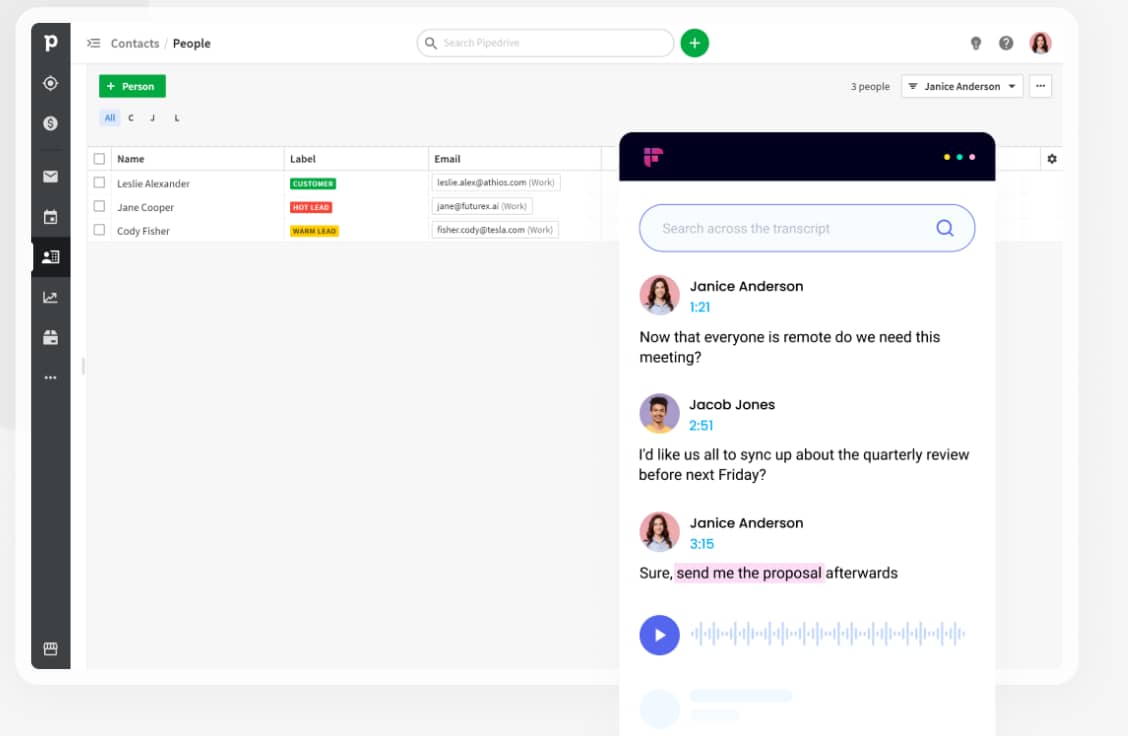
Integrations like these are a form of automation. Removing manual data entry and app-switching gives teams more time and context to focus on customer intimacy.
That time gain is good for productivity and morale.
It’s why 92% of the sales and marketing pros we spoke to use at least one form of automation and they’re happier on average than those who do everything manually.
Want to Learn How to Influence Your Prospect’s Buying Decisions?
5. Balance automation with authentic human connection
Over-relying on automation will make your service feel more robotic than intimate.
Find the right balance to consistently address pain points on a personal level and build long-term relationships.
As a general rule, aim to automate repetitive, low-value tasks and let people handle situations that need empathy and context.
For example:
Welcome emails are a regular occurrence and rarely change. Automate them with email marketing software, like Campaigns.
A customer complaint is more nuanced. It needs the attention of an agent who understands the situation and has problem-solving skills.
Here are some more examples of where automation will and won’t help customer intimacy:
Leave it to automation (productivity gains) | Let humans handle it (customer engagement) |
Updating CRM records and meeting notes | Dealing with complaints and sensitive issues |
Scheduling reminders and follow-ups | Interviewing loyal customers about user experiences |
Answering basic inquiries via chatbot | Empathic communication in support conversations |
Building personal relationships in sales calls | |
Transactional emails (e.g., confirmations, renewals) | Explaining policies or complex solutions |
Gartner predicts that AI will handle 80% of customer service cases by 2029. However, another study shows that 75% of customers prefer talking to humans over automated systems.
Meeting those customers’ expectations will be a strong differentiator.
Customer intimacy in business: examples from B2B and B2C
Seeing customer intimacy in action makes this seemingly abstract idea more tangible.
Here are two examples of businesses that build close relationships throughout the customer journey.
1. B2B SaaS: TrekkSoft
Swiss software company TrekkSoft partnered with Pipedrive to deliver personalized experiences at scale through segmentation and automation.

The team sent tailored campaigns to different customer groups, such as sightseeing tour companies and adventure companies. This approach maintained intimacy while boosting efficiency.
Productivity quadrupled, leads increased and sign-ups grew.
Key takeaway: Automation builds customer loyalty when it delivers more relevant, human-centered experiences.
2. B2C retail: ThirdLove
Lingerie retailer ThirdLove’s Fitting Room tool asks shoppers about past fits, preferred hook settings and brand comfort. Then it recommends the right bra sizes and styles using machine learning algorithms.
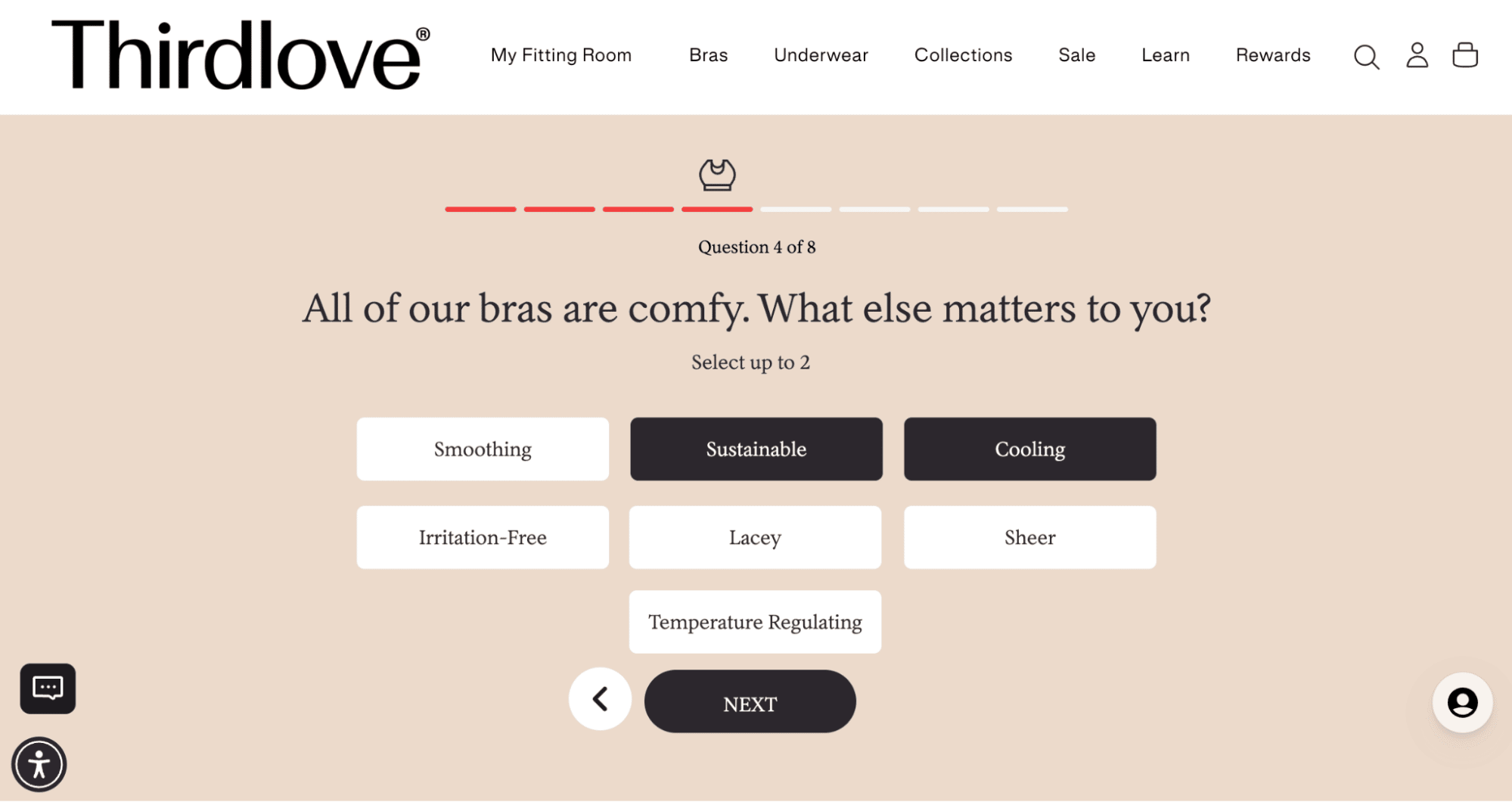
As the company collects fit and feedback data, its recommendations improve. The practical tool becomes a thoughtful, ongoing conversation with each customer. It feels intimate, even without human interaction.
Key takeaway: The more accurate and up-to-date customer data you have, the easier it is to meet buyers’ needs. Organize yours in a CRM system to keep up with trends.
How to measure customer intimacy: 5 key metrics
A few simple sales metrics make customer intimacy clear. Use the following markers to track loyalty, retention and advocacy after implementing your strategy.
Customer intimacy metric | What it means and where to track it |
How many customers stick with you over time, through repeat purchases or subscription renewals Where to look: CRM reports, subscription or repeat purchase data | |
The revenue one customer generates over their relationship with your business Where to look: CRM or accounting software | |
Net Promoter Score (NPS) | How likely customers are to recommend you to others (measured on a 0-10 scale) Where to look: Post-purchase surveys, NPS tools |
Sales growth from existing customers (including upgrades, accessories and recommendations) Where to look: CRM sales dashboards, deal reports | |
Customer feedback response rate and sentiment | The number of survey responses, reviews or comments and whether they’re positive or negative Where to look: Feedback tools (including Pipedrive integrations), review platforms and social media monitoring |
These metrics help you tie actions to outcomes. Use them to build on what works and avoid what doesn’t, then squeeze more value from your sales and marketing budgets.
Final thoughts
Competing on price when entering a new market or growing your startup may seem appealing.
But low prices are easy to copy. They weaken your value and rarely create lasting loyalty.
Customer intimacy offers a much stronger, more sustainable advantage.
Focus on human connections. You’ll create experiences customers remember and recommend for the right reasons. Lower churn and more sales referrals will follow, showing that putting individual buyers first is one of the most reliable ways to lead a market.
Pipedrive’s contact management features help you stay close to the people who matter most. Start your free 14-day trial today and see the difference.








